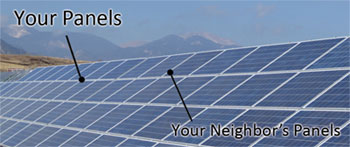Colorado’s Clean Energy Collective, which builds and operates community solar "gardens," is starting three new projects, thanks to a state law that encourages them.
Passed in 2010, the Colorado Community Solar Gardens Act allows people get all the benefits of solar even though its not on their roof. It creates "virtual net metering" by giving them access to the same rebates and incentives that on-site solar has. It also helps utilities because they can count the energy they buy from the gardens toward achieving the state’s Renewable Portfolio Standard. At least 10 people must subscribe to qualify as a solar garden.
In the first phase of the program, the Clean Energy Collective was awarded eight community gardens, for more than 3.5 megawatts (MW) of energy. They serve people in Denver, Boulder, Jefferson, Arapahoe and Summit counties and the City of Aurora.
The three new projects will be 500 kilowatts each, two in Boulder County and one in Denver, bringing affordable solar to several hundred more Excel customers.
The Clean Energy Collective builds and maintains the solar gardens, and the local utility agrees to buy electricity from them. Individuals buy as many solar panels as they want in the "garden" – they get rebates from Excel for buying the panels and credits on their utility bill for the electricity they produce.
Some of its gardens are the 1.1 MW San Miguel Power Association Community Solar Array in southwestern Colorado and Kit Carson community solar garden in New Mexico, which is spread across parking lots and a school.
Another large solar garden is in Colorado Springs. After selling out its solar panels, it’s expanding from 2 MW to a major installation of 10 MW.

"We are leveraging scalability to the benefit of individual panel owners. You don’t even need a roof to adopt clean energy today," says Paul Spencer, founder and CEO of Clean Energy Collective.
The group has about 5.3 MW of community-sited solar PV at 15 solar gardens, expecting to reach 10 MW this year and 100 MW by 2015.
Community solar legislation failed in California after lobbying efforts by PG&E, but it has been re-introduced this year.
Here are Guides to developing community solar.
The Solar Gardens Institute provides tools and training to co-develop community solar arrays. They have a map of the community solar gardens in the US:
